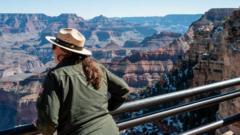The recent drastic measures taken by the Trump administration to slash staff at national parks and forests have ignited outrage among conservationists and outdoor enthusiasts alike, with implications that threaten both visitor experiences and environmental safety.
**Backlash Erupts Over National Parks Staffing Cuts**

**Backlash Erupts Over National Parks Staffing Cuts**
Cuts to operations and staffing at US national parks and forests spark concerns over public safety and the environment.
Despite typically welcoming millions of visitors each year, the ongoing staffing crisis means that vital service roles are being eliminated, leaving parks and forests struggling to maintain essential safety measures and recreation opportunities. As visitors encounter longer lines and closed trails, fears about the degradation of these cherished natural spaces continue to grow.
Kate White and her team are seasoned wilderness rangers who usually clear remnants of human impact, but with mass terminations, their ability to uphold park safety is at risk. The National Park Service and US Forest Service have already lost thousands of staff; approximately 1,000 from the NPS and around 3,400 from the US Forest Service. This low staffing is evident at iconic destinations like the Grand Canyon and Yosemite National Park, where visitor access has been impeded and protests have emerged, including an employee-led demonstration featuring an upside-down American flag during the park's "firefall" event.
Workers like Andria Townsend, a biologist from Yosemite, are worried about the ramifications for endangered species amid increasing uncertainties surrounding conservation efforts. The cuts have compelled them to defend the future of vulnerable wildlife, including the Sierra Nevada red fox and Pacific fisher, both teetering on the brink of extinction.
Even operational standards for visitor safety are at stake, with reports of trail closures made evident shortly after the terminations, undermining the accessibility and upkeep of popular hiking routes. Meanwhile, previous employees express their frustration over job dismissals based on unclear performance assessments, highlighting a disconnect between administration decisions and frontline realities faced in maintaining these scenic landscapes.
In response to public outcry, the government has committed to hiring seasonal workers, although concerns persist about the overall impact on public services and experiences through the coming tourist season. Advocates caution that as staffing decreases, visitors should expect a lack of amenities along with an increase in litter and potential dangers in understaffed areas. Without significant policy changes, the outlook for public interaction with the country's national parks and forests remains grim, sparking urgent calls for action among outdoor advocates and agency leaders alike.
Kate White and her team are seasoned wilderness rangers who usually clear remnants of human impact, but with mass terminations, their ability to uphold park safety is at risk. The National Park Service and US Forest Service have already lost thousands of staff; approximately 1,000 from the NPS and around 3,400 from the US Forest Service. This low staffing is evident at iconic destinations like the Grand Canyon and Yosemite National Park, where visitor access has been impeded and protests have emerged, including an employee-led demonstration featuring an upside-down American flag during the park's "firefall" event.
Workers like Andria Townsend, a biologist from Yosemite, are worried about the ramifications for endangered species amid increasing uncertainties surrounding conservation efforts. The cuts have compelled them to defend the future of vulnerable wildlife, including the Sierra Nevada red fox and Pacific fisher, both teetering on the brink of extinction.
Even operational standards for visitor safety are at stake, with reports of trail closures made evident shortly after the terminations, undermining the accessibility and upkeep of popular hiking routes. Meanwhile, previous employees express their frustration over job dismissals based on unclear performance assessments, highlighting a disconnect between administration decisions and frontline realities faced in maintaining these scenic landscapes.
In response to public outcry, the government has committed to hiring seasonal workers, although concerns persist about the overall impact on public services and experiences through the coming tourist season. Advocates caution that as staffing decreases, visitors should expect a lack of amenities along with an increase in litter and potential dangers in understaffed areas. Without significant policy changes, the outlook for public interaction with the country's national parks and forests remains grim, sparking urgent calls for action among outdoor advocates and agency leaders alike.






















